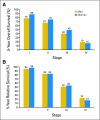Multidisciplinary meeting on male breast cancer: summary and research recommendations
- PMID: 20308661
- PMCID: PMC2860409
- DOI: 10.1200/JCO.2009.25.5729
Multidisciplinary meeting on male breast cancer: summary and research recommendations
Abstract
Male breast cancer is a rare disease, accounting for less than 1% of all breast cancer diagnoses worldwide. Most data on male breast cancer comes from small single-institution studies, and because of the paucity of data, the optimal treatment for male breast cancer is not known. This article summarizes a multidisciplinary international meeting on male breast cancer, sponsored by the National Institutes of Health Office of Rare Diseases and the National Cancer Institute Divisions of Cancer Epidemiology and Genetics and Cancer Treatment and Diagnosis. The meeting included representatives from the fields of epidemiology, genetics, pathology and molecular biology, health services research, and clinical oncology and the advocacy community, with a comprehensive review of the data. Presentations focused on highlighting differences and similarities between breast cancer in males and females. To enhance our understanding of male breast cancer, international consortia are necessary. Therefore, the Breast International Group and North American Breast Cancer Group have joined efforts to develop an International Male Breast Cancer Program and to pool epidemiologic data, clinical information, and tumor specimens. This international collaboration will also facilitate the future planning of clinical trials that can address essential questions in the treatment of male breast cancer.
Conflict of interest statement
Authors' disclosures of potential conflicts of interest and author contributions are found at the end of this article.
Figures


References
-
- Jemal A, Siegel R, Ward E, et al. Cancer statistics, 2009. CA Cancer J Clin. 2009;59:225–249. - PubMed
-
- Anderson WF, Chu KC, Chang S, et al. Comparison of age-specific incidence rate patterns for different histopathologic types of breast carcinoma. Cancer Epidemiol Biomarkers Prev. 2004;13:1128–1135. - PubMed
-
- Engholm G, Ferlay J, Christensen N, et al. Copenhagen, Denmark: Danish Cancer Society; 2009. NORDCAN: Cancer Incidence, Mortality and Prevalence in the Nordic Countries, Version 3.4, Association of Nordic Cancer Registries.
-
- Couch FJ, Farid LM, DeShano ML, et al. BRCA2 germline mutations in male breast cancer cases and breast cancer families. Nat Genet. 1996;13:123–125. - PubMed
-
- Haraldsson K, Loman N, Zhang QX, et al. BRCA2 germ-line mutations are frequent in male breast cancer patients without a family history of the disease. Cancer Res. 1998;58:1367–1371. - PubMed
Publication types
MeSH terms
Grants and funding
LinkOut - more resources
Full Text Sources
Medical

